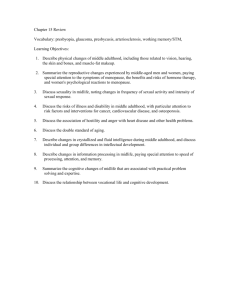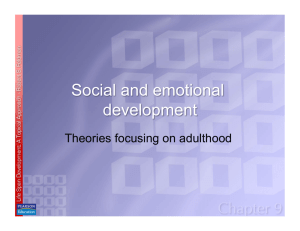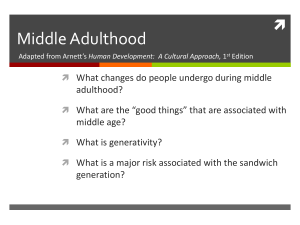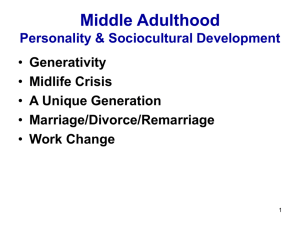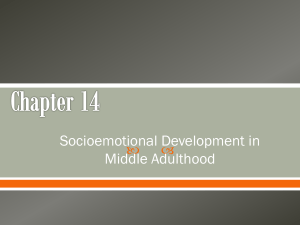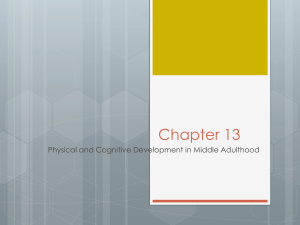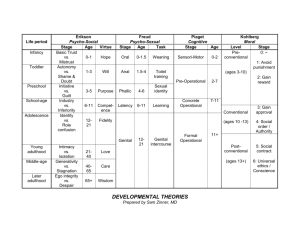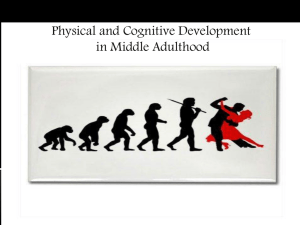Development VI: Middle Adulthood (40
advertisement
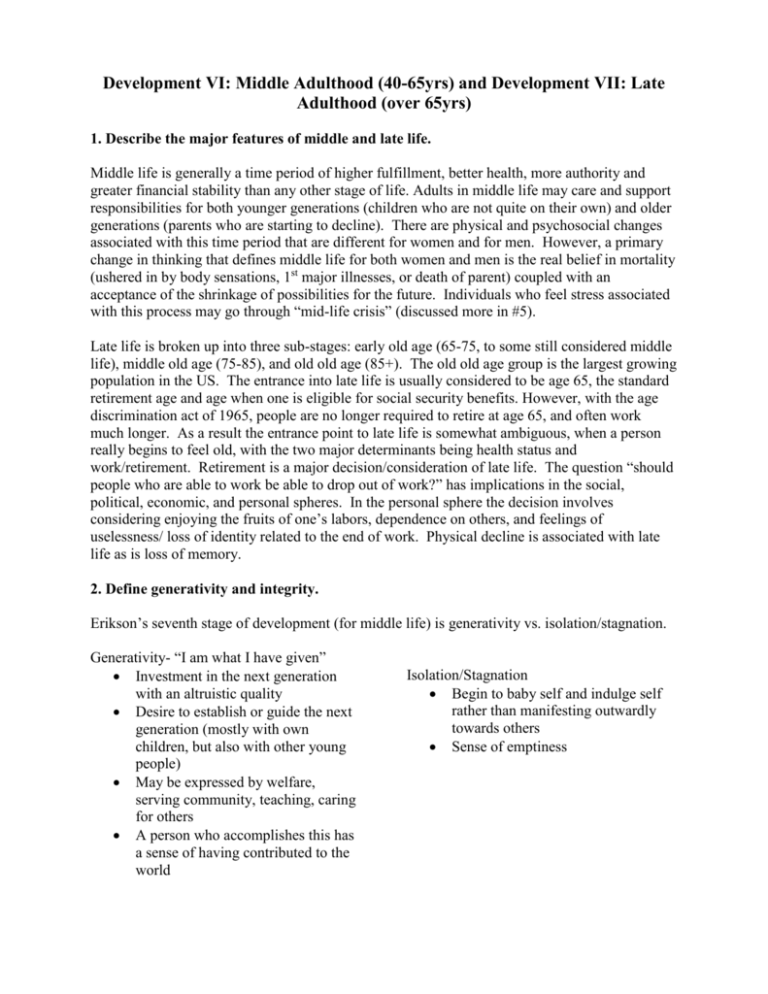
Development VI: Middle Adulthood (40-65yrs) and Development VII: Late Adulthood (over 65yrs) 1. Describe the major features of middle and late life. Middle life is generally a time period of higher fulfillment, better health, more authority and greater financial stability than any other stage of life. Adults in middle life may care and support responsibilities for both younger generations (children who are not quite on their own) and older generations (parents who are starting to decline). There are physical and psychosocial changes associated with this time period that are different for women and for men. However, a primary change in thinking that defines middle life for both women and men is the real belief in mortality (ushered in by body sensations, 1st major illnesses, or death of parent) coupled with an acceptance of the shrinkage of possibilities for the future. Individuals who feel stress associated with this process may go through “mid-life crisis” (discussed more in #5). Late life is broken up into three sub-stages: early old age (65-75, to some still considered middle life), middle old age (75-85), and old old age (85+). The old old age group is the largest growing population in the US. The entrance into late life is usually considered to be age 65, the standard retirement age and age when one is eligible for social security benefits. However, with the age discrimination act of 1965, people are no longer required to retire at age 65, and often work much longer. As a result the entrance point to late life is somewhat ambiguous, when a person really begins to feel old, with the two major determinants being health status and work/retirement. Retirement is a major decision/consideration of late life. The question “should people who are able to work be able to drop out of work?” has implications in the social, political, economic, and personal spheres. In the personal sphere the decision involves considering enjoying the fruits of one’s labors, dependence on others, and feelings of uselessness/ loss of identity related to the end of work. Physical decline is associated with late life as is loss of memory. 2. Define generativity and integrity. Erikson’s seventh stage of development (for middle life) is generativity vs. isolation/stagnation. Generativity- “I am what I have given” Investment in the next generation with an altruistic quality Desire to establish or guide the next generation (mostly with own children, but also with other young people) May be expressed by welfare, serving community, teaching, caring for others A person who accomplishes this has a sense of having contributed to the world Isolation/Stagnation Begin to baby self and indulge self rather than manifesting outwardly towards others Sense of emptiness Erikson’s eighth stage of development (for late life) is integrity vs despair. Integrity- “I am what I have given/been…it has been good, great, integral” Satisfaction and pride in past accomplishments, contributions, and influence on others Successful solution to mortality leaving sense of peace Leads to a different love of one’s parents, acceptance of fact that one’s life is one’s own responsibility Despair Feeling of loss and regret Feeling of not having had a good life, that it has been taken away Belief in having made wrong choices, having had limited choices and/or bad luck Cynicism Can lead to clinical depression (suicide rates increase with old age especially in men) 3. Discuss the shifts in marriage and work in middle age. In middle life, couples commonly confront “empty nest syndrome” with the move of the youngest child out of the house. There is often a shift in roles between women and men in middle life called the midlife cross-over that strongly affects marriage. In early adulthood, women tend to be concerned with intimacy, while men are concerned with individual pursuits (ie. work/career). At middle adulthood, there is a direct reversal as women come into their own with greater importance placed on work/career and personal goals and men become more aware or more needful of intimacy. While divorces are most common during the first 4-7yrs of a marriage, the second most frequent period is at midlife. Divorce is often linked to infidelity with 60-70% of men and 20-30% of women engaging in infidelity at some point in life. There is a high rate of remarriage in midlife, especially among men. 4. Discuss the main psychosocial and physiological changes seen in late years. Middle Life Physiological changes: Evidence of decline manifests Skin loses elasticity (wrinkles) Lens of eye loses elasticity and becomes harder, reduction in visual acuity Cardiopulmonary reserve reduced Bones lose some calcium Back and joint pain/stiffness Men have no clear physical demarcation of passage into middle life. For women, menopause is the demarcation point, with the stop in production of ova first and later cessation of menses. Menopause has effects on mood and is associated with hot flashes, which generally last for a few months. Some reduction of lubrication in the vaginal cavity may occur leading to pain during intercourse. Many women view menopause as a benefit (no periods, no worries about pregnancies). Psychosocial changes: Real belief in mortality (ushered in by body sensations, 1st major illnesses, or death of parent) Idea that maybe more time has gone by than remains leads to time becoming more real Realization of shrinkage of possibilities associated with giving up of old hopes and dreams Midlife cross-over in roles for men and women within relationships and with respect to work With aging parents and children that may not be on their own, social responsibilities may lie with both older and younger generations Late Life Physiological changes: Loss of cells Diminished function physically in all areas (including sexually) Disturbance in memory and mental capacity Greatest concern for most people is over loss of memory. The strife over this loss is due to the fact that humanity is lodged in memory of experiences – “I lose my memory, I lose my being.” Memory loss is seen in slower speed of recall and reduced capacity to retrieve, especially irregularly used information and short term memories. Stress exacerbates memory loss. Memories associated with emotional events are more readily recalled. In contrast to memory, judgment improves with age as older people are less concerned over the details and more able to see things from the global view level of perspective. Psychosocial changes: Loss of previous social role with retirement Dependency on others as health declines Greater importance placed on the quality of life, being able to enjoy life and being of use to others Embarrassment associated with physical changes (loss of bladder control, need for help with mobility, etc.) 5. Discuss mid-life crisis. Mid-life crisis is a controversial issue; some people believe in it and others think it is a myth. It is generally considered to result from recognition that future possibilities have diminished and all goals and dreams set earlier in life will not be met. For some people this does not cause stress and results in a sense of relief and no crisis. Others focus on mortality, become attached to the idea that more time has gone by than remains, see the beginnings of physical decline, and feel stress at the fact that they are not where they want to be in life. This stress may lead to actual grief and depression. These people make seemingly dramatic changes, searching for youth, new relationships, and/or new careers in an attempt to get to where they want to be in life. People who argue against the concept of mid-life crisis believe that this generally takes place with people who are more restless to begin with, that these changes are consistent with the person’s tendencies upon self reflection, and there is no change in personality. 6. Discuss two major causes of despair in the elderly. Despair can result from losses of any kind, but primary causes are loss of health and independence and loss of identity due to reduction in social status and memory.
